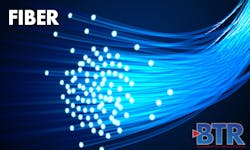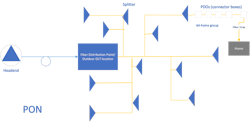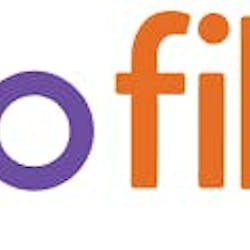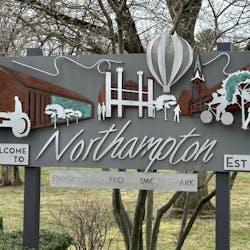In Part 1, we examined many of the considerations that operators face when planning to upgrade their HFC networks to Next-Generation HFC, including Distributed Access Architecture, Full Duplex DOCSIS, and Extended Spectrum DOCSIS. What if we put all of this aside and consider fiber to the home (FTTH) instead? Passive optical network (PON) systems have been around for decades and are making inroads among cable operators in both greenfield (new construction) and brownfield (upgrade) situations. FTTH systems using PON are worth a look.
Why FTTH?
Unlike with HFC networks, FTTH is not constrained by competing upstream and downstream bandwidth allocations. With transmission capabilities starting at 1 Gbps symmetrical for basic GPON or EPON networks, there is no need to compromise. Latency of PON systems is already in the single-digit millisecond range.
As an outside plant (OSP) technology, there are no metallic components to corrode. “Fiber maintenance” is sort of an oxymoron – fiber does not require maintenance. Virtually the only time you will repair a fiber is if it is broken or damaged by an external event, such as a traffic accident resulting in a downed pole, tree fall, or backhoe cut. There is no RF signal leakage, hence no CLI patrols, measurements, or reports. Even the most ardent supporters of HFC agree that fiber is indeed superior – the contention surrounds the cost to deploy it.
We can examine the methods and costs to provide FTTH service, and then compare to those of Next-Gen HFC upgrades.
PON Basics
The basic architecture of all PONs is based on the Full Service Access Network (FSAN) model (see Figure 1). Individual fibers run from the optical line terminal (OLT) to a splitter. The splitter outputs feed 32 or 64 individual user homes (or businesses). This same architecture is used for GPON, EPON, 10G-EPON, XGS-PON, or NG-PON2, and indeed also for RFOG.
These different PON flavors have varying costs and benefits. On a basic level, GPON, XGS-PON, and NG-PON2 are based on ITU standards, while EPON and 10G-EPON are based on IEEE standards. The GPON network (trunk) transmission speeds are 2.5 Gbps down and 1.2 Gbps up; EPON is 1 Gbps down and up, XGS-PON and 10G-EPON are 10 Gbps down and up, and NG-PON2 ranges from 10 Gbps down and up to 40 Gbps down and up or higher based on the number of wavelengths used.
GPON and EPON have the lowest equipment cost.
Fortunately, GPON can coexist on the same fiber with XGS-PON and EPON with 10G-EPON, so if speeds beyond 1 Gbps are in the far future, an upgrade is possible with just an addition of OLT and ONT equipment.
Construction
Brownfield building of FTTH requires not only replacement of all OSP coaxial cable with fiber cable, but also replacement of cable drops to each home with fiber drops. Inside the home, fiber must be brought to the optical network terminal (ONT) location, and that location requires power and access to any in-home wiring required to service the devices. Unlike with coaxial drops, the fiber drop produces negligible loss and length need not be considered.
Disruption of Service
In Part 1, we discussed how upgrading the coaxial network would cause at least some disruption of service for all customers. FTTH, on the other hand, can be constructed as a completely separate network and not disrupt the service of coaxial customers until the day comes to transition each individual customer to the optical network.
Terminal Equipment
When an optical system replaces DOCSIS over coax, a new termination device is required between the OSP and the router (see Figure 2). The ONT replaces the cable modem and has a cost associated with it. If legacy video service over coax was present, set-top boxes would need to be replaced by IPTV boxes, as MPEG video over RF channels is no longer possible. (Hybrid RF-overlay approaches do enable preservation of RF set-top boxes in a PON; however, this adds cost and complexity.)
An IPTV system must be present to feed the video service on the optical network. This service can be provided by the operator or a third-party IPTV provider. IPTV boxes are available at costs far lower than conventional RF-QAM set-top boxes. In addition, “Smart TVs” can take a data feed directly and, with appropriate software, decode and display an operator’s IPTV service.
Voice services may be provided using a standard voice adapter (ATA), either standalone or included in the ONT hardware.
Back Office
When PONs were first introduced, ONTs were provisioned very differently from cable modems. Soon, CableLabs stepped in with the DOCSIS Provisioning of EPON (DPoE) specification. Today, PON vendors and third parties have created systems that can emulate DOCSIS provisioning and allow GPON or EPON based networks and DOCSIS networks to operate side-by-side.
Totaling the Costs
We can divide the build costs for FTTH into three major building blocks: transport network, access network, and CPE.
The transport network includes the fiber strands from the headend out to the neighborhoods. In a brand-new network, you would probably run these directly out of OLT units in the central office or headend to the PON splitters described above. If we are overlaying on an existing HFC network, you would instead try to use existing fibers. There will not be enough of them to directly feed the PON splitters, so instead remote OLTs can be strategically located near existing HFC nodes and fed with dense wavelength-division multiplexing (DWDM) using a limited amount of spare fibers in the HFC network. By using spare fibers to build the transport portion of the network, construction costs will be comparatively low. The DWDM overlay equipment can employ low-cost pluggable optical transceivers. The output of the remote OLTs feeds the PON splitters.
The access network includes the PON splitters, fibers to the drop access points (PDOs), and fiber drops to each home or business. Access fiber plant would need to be newly constructed – this will form the bulk of the network expense and must be designed and built to enable all homes or businesses to each have a fiber port.
CPE includes the ONT and any other routing or IPTV equipment as well as in-home fiber wiring. The drops and CPE are only required for each customer as they obtain service – but is a very costly proposition if every home is to be converted from HFC to fiber.
Hybrid Approach
When a FTTH network is built alongside an HFC network, there is a time when both networks will be operating. Traditionally, this time is minimized such that the operator can take quick advantage of the reduced operating cost associated with FTTH versus HFC. This opex gain comes at a tremendous cost, however. Customers that might never have wanted higher-speed services must be visited and converted. Every set-top box must be replaced. As mentioned above, visiting each home not only requires operator action but also requires that the customer be home for a scheduled appointment. These actions help drive the cost estimates for FTTH upgrades far above those of Next-Gen HFC upgrades.
What if you built the FTTH network overlay, but only connected the homes that wanted higher-speed services? Yes, you are operating two networks; however, the costs of connecting the fiber network are limited to homes paying for the upgraded services. In addition, legacy video services can remain on the HFC network until replaced with IPTV at the customer’s and operator’s convenience. The service appointment to “convert” to fiber is rolled into the installation appointment for new services, minimizing disruption.
Conclusion
When comparing the costs of upgrading an existing network to Next-Generation HFC or FTTH, many factors must be considered. The ultimate long-term operating cost, however, will determine if the decision to go FTTH was a wise one. A long-term hybrid approach where the legacy HFC network continues to operate as FTTH service is offered may provide a good strategic bridge to the ultimate all-fiber network.
Jack Burton is principal at Broadband Success Partners.







